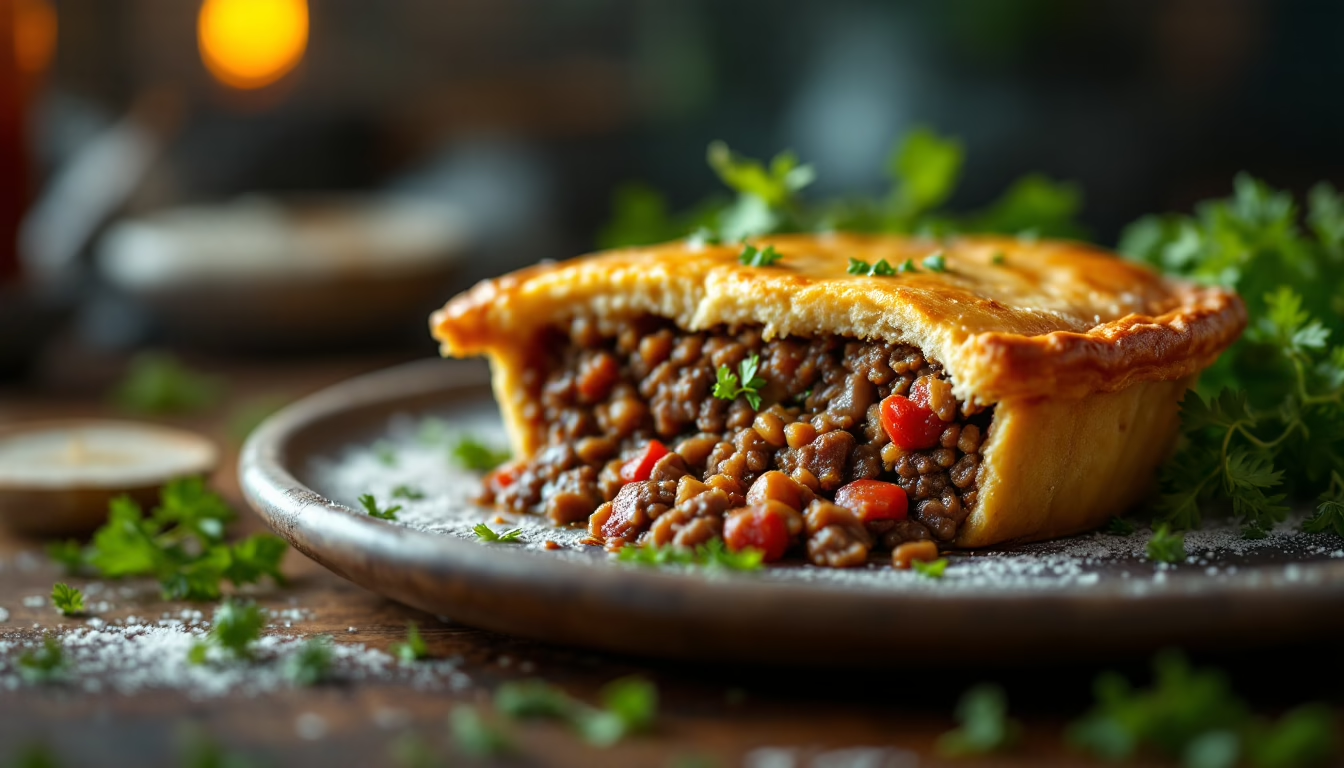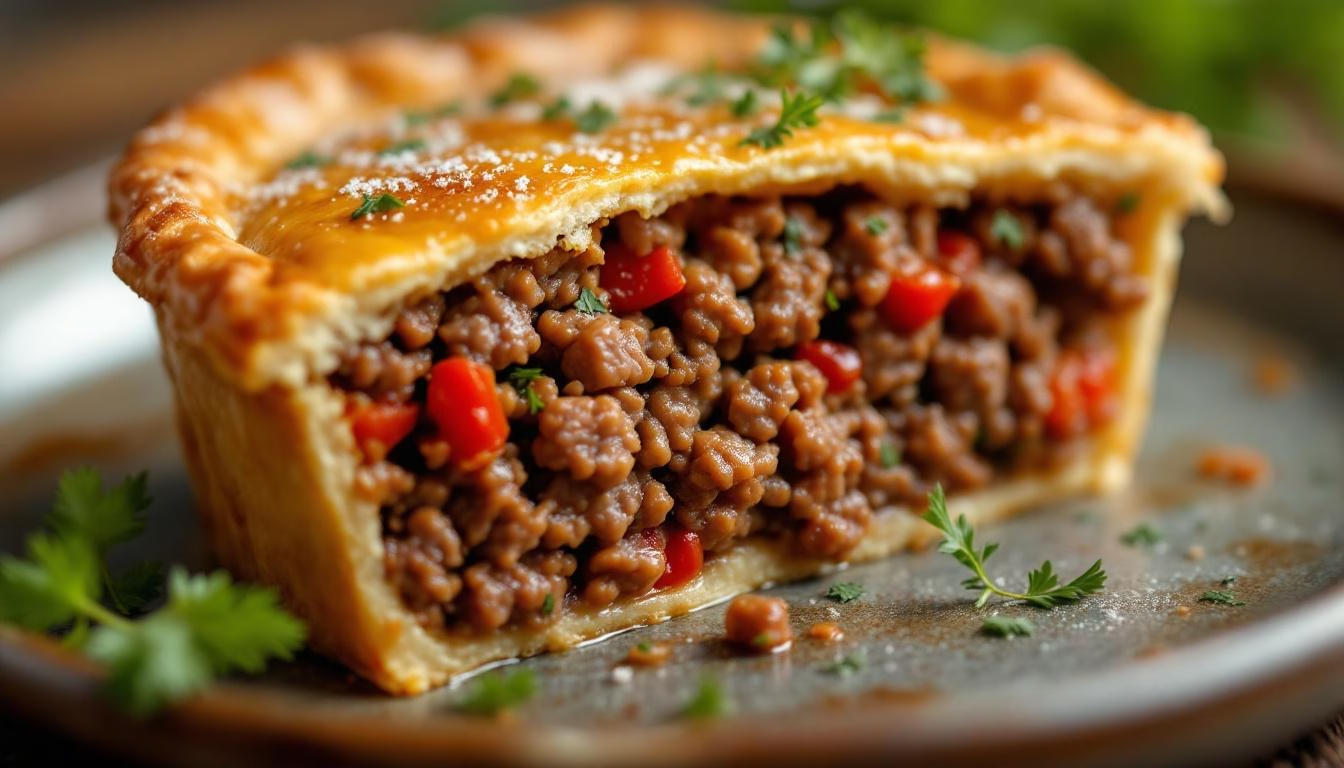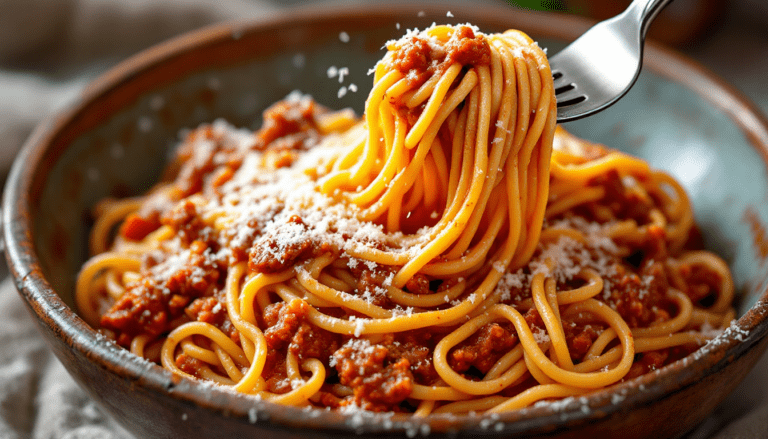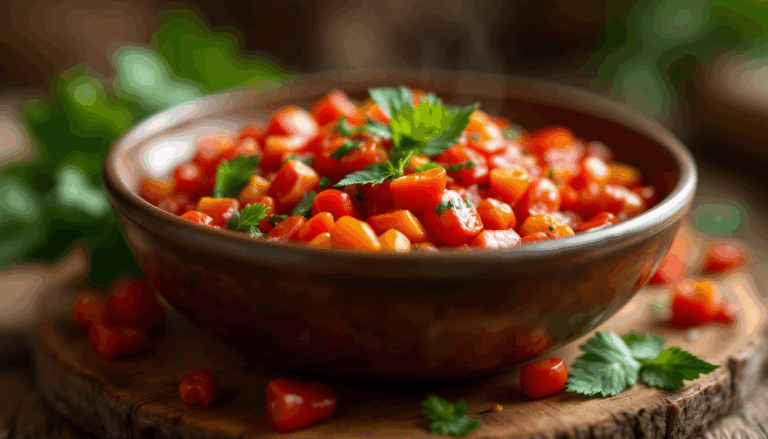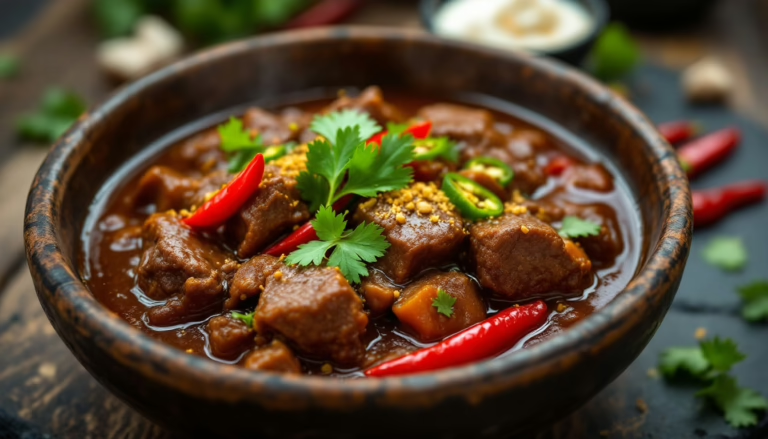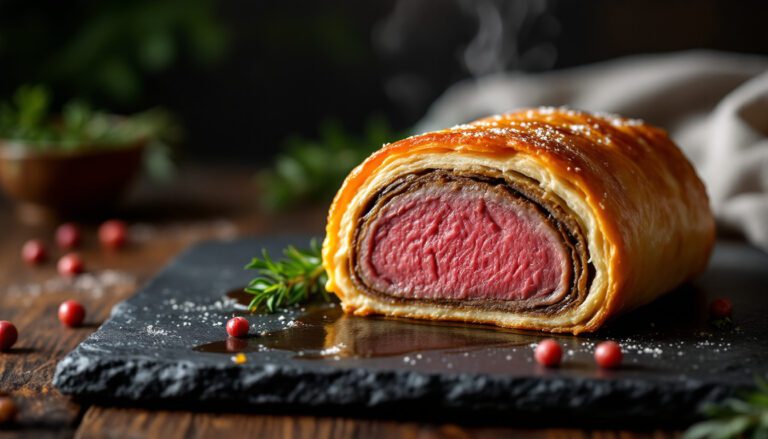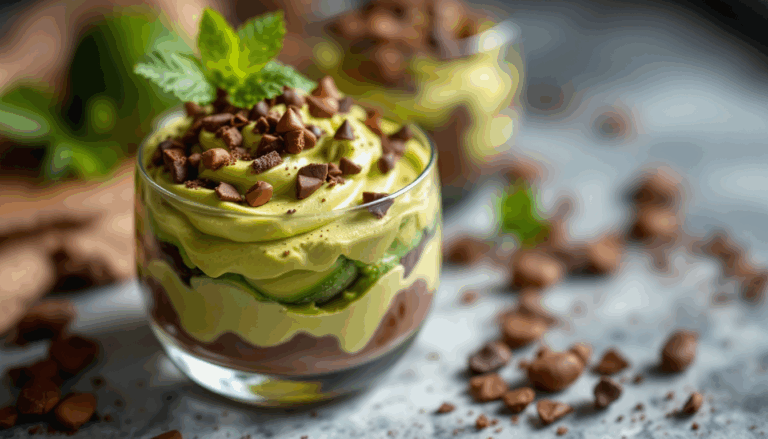Ultimate Minced Beef Pie Recipe
The Ultimate Minced Beef Pie Recipe That Actually Works (No Soggy Bottoms Here) – You know that moment when you’re standing in your kitchen at 5:47 PM, staring into the fridge like it might magically conjure dinner plans, and all you’ve got is a pound of ground beef that’s been judging you from the meat drawer for three days?
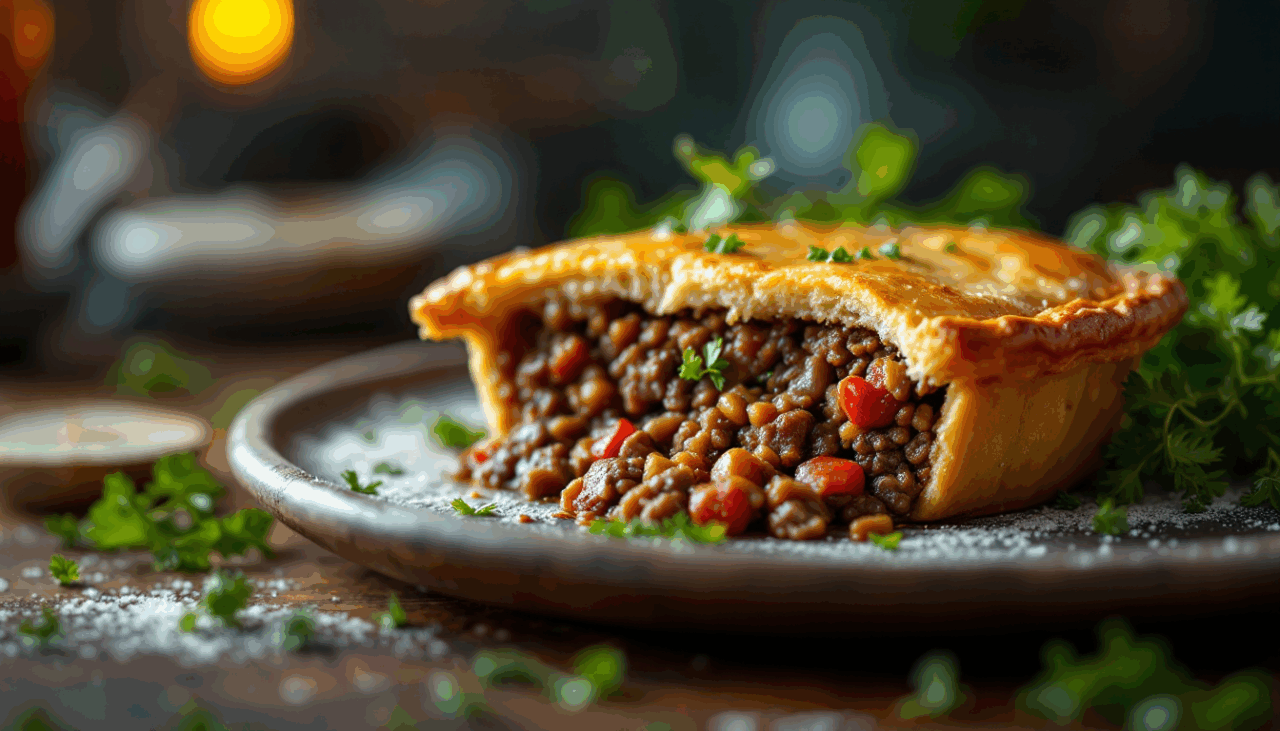
Minced Beef Pie
Ingredients
- 2 tbsp Vegetable Oil
- 500g Minced Beef
- 1 chopped Onion
- 1 tbsp Tomato Puree
- 1u00bd tbsp Plain Flour
- 75g Mushrooms
- 250ml Beef Stock
- Dash Worcestershire Sauce
- 400g Shortcrust Pastry
- 1 Egg Yolk
Instructions
- Preheat the oven to 200C/400F/Gas 6.
- Heat the oil in a deep frying pan and fry the beef mince for 4-5 minutes, breaking it up with a wooden spoon as it browns.
- Add the onion and cook for 2-3 minutes, then stir in the tomato puru00e9e and cook for 2-3 more minutes. Stir in the flour and cook for a further minute, then add the chopped mushrooms, the stout or beef stock and a couple of dashes of Worcestershire sauce.
- Bring to the boil, then reduce the heat, cover the pan with a lid and leave to simmer for 20 minutes. Set aside and leave to cool, then turn the meat mixture into a one litre pie dish.
- Roll out the pastry on a floured work surface until it is slightly larger than the pie dish. Gently drape the pastry over the dish, pressing firmly onto the edges. Trim, then shape the edges into a fluted shape.
- Cut some leaf shapes out of the pastry trimmings and decorate the top of the pie, sticking them to the pastry with the beaten egg yolk. Make three or four slits in the pastry to allow the steam to escape, then brush the pie with the rest of the beaten egg yolk.
- Bake in the oven for 20-25 minutes, or until golden-brown. To serve, slice into wedges.
Nutrition
Yeah, me too.
Last Tuesday was one of those nights—the kind where ordering takeout feels like giving up on adulthood entirely, but the thought of making anything more complicated than toast makes me want to crawl under my duvet and pretend I’m someone who meal plans.
That’s when I remembered this minced beef pie recipe that my friend Sarah swears by.
Sarah is one of those people who somehow manages to have fresh herbs growing on her windowsill and never runs out of milk (how?), but she’s also refreshingly honest about kitchen disasters.
When she told me this pie was “foolproof,” I was skeptical because, honestly, I’ve proven many a “foolproof” recipe quite wrong.
But desperation makes brave bakers of us all, and I figured even if I completely botched it, I’d still end up with something encased in pastry, which is basically guaranteed comfort food.
Three hours later, I was pulling a golden, flaky-topped masterpiece from my oven, and my entire apartment smelled like a British pub on a rainy Sunday.
My neighbor actually knocked on my door to ask what I was cooking—and this is the same neighbor who once politely suggested I open my windows when I accidentally set off the smoke alarm making grilled cheese.
The pie was everything I didn’t know I needed: rich, savory, satisfying in that soul-deep way that only proper comfort food can manage, and surprisingly achievable for a Tuesday night panic dinner.
The Story Behind This Classic British Minced Beef Pie Recipe with Golden Pastry
Minced beef pie is one of those wonderfully unpretentious dishes that’s been feeding British families for generations, the kind of recipe that gets passed down not because it’s fancy, but because it works.
It’s essentially a meat pie that doesn’t require you to roll out pastry for both the bottom and top (thank goodness), making it infinitely more approachable for those of us who haven’t quite mastered the art of pastry perfection.
What I love about this particular minced beef pie recipe is that it strikes that perfect balance between “fancy enough for company” and “comforting enough for a random Wednesday.” It’s the kind of dish that makes you feel like you’ve accomplished something substantial in the kitchen without requiring a culinary degree or a pantry stocked with ingredients you can’t pronounce.
The filling is rich and deeply flavored—thanks to a combination of tomato purée, mushrooms, and a splash of Worcestershire sauce that adds that indefinable umami depth—while the pastry top provides that satisfying contrast of textures that makes every bite interesting.
The beauty of this recipe lies in its flexibility and forgiveness.
Unlike some temperamental dishes that fall apart if you breathe on them wrong, this minced beef pie actually improves with a bit of rustic charm.
Slightly uneven pastry edges?
Character.
A few extra minutes in the oven?
Enhanced golden color.
It’s the kind of recipe that adapts to your skill level and still delivers something delicious.
Ingredients You’ll Need
Before we dive into the step-by-step process, let’s talk about what goes into making this minced beef pie recipe sing.
Most of these ingredients are probably already lurking in your kitchen, which is part of what makes this dish so appealing for those spontaneous cooking moments.
For the Filling:
- 2 tablespoons vegetable oil
- 500g minced beef (I prefer 80/20 for the right balance of flavor and texture)
- 1 large onion, chopped
- 1 tablespoon tomato purée
- 1½ tablespoons plain flour
- 75g mushrooms, chopped (button or cremini work beautifully)
- 250ml beef stock (or stout if you’re feeling adventurous)
- A generous dash of Worcestershire sauce
- Salt and freshly ground black pepper to taste
For the Pastry Top:
- 400g ready-made shortcrust pastry (life’s too short to make everything from scratch)
- 1 egg yolk, beaten (save the white for tomorrow’s scrambled eggs)
Step-by-Step Instructions
Now, let’s walk through this minced beef pie recipe together, and I promise to tell you about all the little moments where things might go slightly sideways—and why that’s totally okay.
Preparing Your Kitchen and Preheating
First things first: preheat your oven to 200C/400F/Gas 6.
I know, I know, preheating feels like an unnecessary step when you’re hungry, but trust me on this one.
A properly heated oven is the difference between a gorgeously golden pastry top and something that looks like it gave up halfway through baking.
While your oven is warming up, gather all your ingredients on the counter.
This isn’t just chef-y showing off—it actually makes the cooking process so much smoother when you’re not frantically searching for the Worcestershire sauce while your onions are threatening to burn.
Building the Flavor Base
Heat the vegetable oil in a deep frying pan over medium-high heat.
When the oil shimmers slightly (it should move easily when you tilt the pan), add your minced beef.
Here’s where many people go wrong with their minced beef pie recipe: they overcrowd the pan or cook over heat that’s too low.
You want to hear that satisfying sizzle when the meat hits the oil.
Break up the mince with a wooden spoon as it browns—and I mean really break it up.
Those large clumps might look impressive, but they’ll create uneven cooking and awkward bites in your finished pie.
Cook for 4-5 minutes, until the meat is properly browned.
Don’t rush this step; proper browning creates the foundation of flavor for your entire pie.
Adding Aromatics and Building Depth
Once your beef is beautifully browned, add the chopped onion to the pan.
The moisture from the onions will help deglaze any delicious browned bits stuck to the bottom of your pan—those are pure flavor gold, so don’t let them go to waste.
Cook for 2-3 minutes until the onions start to soften and turn translucent.
Next comes the tomato purée, and here’s a little trick I learned the hard way: cook it for a full 2-3 minutes.
Raw tomato purée has a sharp, almost metallic taste, but cooking it briefly transforms it into something rich and concentrated.
Stir it around, let it coat the meat and onions, and watch as everything takes on a lovely reddish hue.
The Thickening Magic
Sprinkle the flour over your meat mixture and stir it in thoroughly.
This might look a bit weird at first—suddenly everything gets a bit chalky and thick—but this flour is going to be what transforms your beef stock into a proper gravy that holds your pie together.
Cook for another minute to eliminate any raw flour taste.
Now add your chopped mushrooms, the beef stock (or stout, if you’re feeling fancy), and a generous dash of Worcestershire sauce.
I’m deliberately vague about the Worcestershire because “a dash” means different things to different people, and honestly, it’s hard to add too much.
Start with a good shake or two, taste later, and adjust as needed.
The Patient Simmer
Bring everything to a boil, then reduce the heat to low, cover the pan with a lid, and let it simmer for 20 minutes.
This is not the time to rush things—that simmering time allows all the flavors to meld together and the liquid to reduce into something rich and glossy.
Set a timer, because 20 minutes feels both forever and no time at all when you’re cooking.
After simmering, set the mixture aside to cool.
This cooling step is crucial for your minced beef pie recipe success—hot filling will make your pastry soggy and difficult to handle.
While it’s cooling, turn the mixture into a one-liter pie dish.
I use a ceramic dish because it conducts heat evenly, but any oven-safe dish of similar size will work perfectly.
Pastry Perfection (Or Close Enough)
Roll out your shortcrust pastry on a floured work surface until it’s slightly larger than your pie dish.
“Slightly larger” means about 2 inches bigger all around—enough to drape over the edges and trim neatly.
If your pastry cracks a bit while rolling, don’t panic.
Press it back together with your fingers, or patch it with a small piece.
Rustic charm is completely acceptable here.
Gently drape the pastry over your pie dish, pressing firmly onto the edges.
Trim the excess pastry, leaving about an inch overhang, then shape the edges into a fluted pattern.
If you’ve never fluted pastry edges before, don’t stress—just pinch the edges with your fingers in a regular pattern.
It doesn’t need to look professional to taste amazing.
Final Touches and Baking
Here’s where you can get a bit creative: cut some leaf shapes out of your pastry trimmings and arrange them on top of your pie.
Stick them down with a bit of the beaten egg yolk.
These little decorative touches make your minced beef pie recipe look like something from a proper British bakery, even if your knife skills are more “enthusiastic” than “precise.”
Make three or four slits in the pastry to allow steam to escape—this prevents your pastry from puffing up too much and potentially cracking.
Brush the entire top with the remaining beaten egg yolk for that gorgeous golden finish.
Bake for 20-25 minutes, or until the pastry is golden-brown and your kitchen smells absolutely incredible.
The exact timing depends on your oven and the depth of your pie dish, so keep an eye on it during the last few minutes.
Tips for Minced Beef Pie Success
After making this minced beef pie recipe more times than I can count, I’ve learned a few tricks that make the difference between “good” and “absolutely incredible.”
Choose Your Beef Wisely
Not all minced beef is created equal for pie-making.
I’ve found that 80/20 ground beef (80% lean, 20% fat) gives you the perfect balance of flavor and texture.
Leaner mince can result in a drier filling, while fattier options might make your pie greasy.
If you can only find very lean mince, add a tablespoon of olive oil to the pan before browning.
Don’t Skip the Browning
Proper browning isn’t just about color—it’s about flavor.
That Maillard reaction happening when your beef hits the hot oil creates hundreds of complex flavor compounds that you simply can’t achieve any other way.
Take your time with this step, and don’t overcrowd your pan.
If necessary, brown your mince in batches.
Stock vs. Stout: A Delicious Dilemma
While beef stock creates a classic, family-friendly version of this minced beef pie recipe, substituting stout beer adds an incredible depth of flavor.
The slight bitterness of the stout balances beautifully with the richness of the beef, creating something that tastes far more sophisticated than the effort required.
Guinness works particularly well, but any dark stout will do.
Pastry Handling 101
Working with pastry can feel intimidating, but it’s more forgiving than you think.
Keep your hands cool (run them under cold water and dry thoroughly if they’re warm), work quickly, and don’t overhandle the dough.
If your pastry tears, simply patch it with a small piece and press firmly—no one will notice once it’s baked.
Make-Ahead Magic
This minced beef pie recipe is actually better when the filling is made a day ahead.
The flavors have more time to develop, and cold filling is much easier to work with when assembling your pie.
You can prepare the filling, store it covered in the refrigerator, then add the pastry top and bake when you’re ready to eat.
Delicious Variations to Try
Once you’ve mastered the basic minced beef pie recipe, there are endless ways to make it your own.
Here are some of my favorite variations that have emerged from various kitchen experiments (some more successful than others).
Mediterranean Twist
Add diced bell peppers with the onions, substitute oregano and thyme for the Worcestershire sauce, and include a handful of olives in the filling.
Top with crumbled feta cheese before adding the pastry.
This version transports your taste buds straight to a Greek taverna.
Cheesy Comfort Version
Stir 100g of grated sharp cheddar into the cooled filling before topping with pastry.
The cheese melts during baking, creating pockets of gooey deliciousness throughout the pie.
This variation is particularly popular with children and adults who refuse to fully grow up (like me).
Spicy Mexican-Inspired
Add diced jalapeños with the onions, substitute cumin and paprika for some of the Worcestershire sauce, and include a tin of drained black beans in the filling.
Serve with a dollop of sour cream and fresh cilantro.
It’s fusion cooking at its most delicious.
Root Vegetable Addition
Dice carrots, parsnips, or potatoes and add them with the mushrooms.
This creates a more substantial, hearty filling that’s perfect for cold weather.
The vegetables add natural sweetness and extra nutrition, making you feel slightly better about having pie for dinner.
What to Expect (And How to Avoid Common Pitfalls)
Let’s be real about what happens when you make this minced beef pie recipe.
Your first attempt might not look like something from a glossy cookbook, and that’s perfectly okay.
Mine certainly didn’t—the pastry was unevenly rolled, the edges were more “rustic” than “elegant,” and I may have been a bit heavy-handed with the Worcestershire sauce.
But it was absolutely delicious, and that’s what matters.
The most common issue I see people encounter is soggy pastry, which usually happens when the filling is too hot when you add the pastry top, or when there isn’t enough thickening in the filling.
Make sure your filling has cooled completely, and don’t skip that flour step—it’s what transforms your cooking liquid into a proper sauce that won’t make your pastry soggy.
Another thing to expect: your kitchen will smell absolutely incredible while this bakes.
I’m talking about the kind of aroma that makes neighbors suddenly remember they need to borrow something.
The combination of browning pastry and savory filling is pure comfort food magic.
This minced beef pie recipe serves about 4-6 people generously, depending on what you’re serving alongside it.
I like to serve it with simple steamed vegetables or a crisp green salad—something fresh to balance the richness of the pie.
Leftovers keep well in the refrigerator for up to three days and reheat beautifully in a low oven.
Most importantly, don’t stress about perfection.
This is comfort food, meant to nourish and satisfy, not to win beauty contests.
Some of the most delicious pies I’ve made have been the slightly imperfect ones, where the pastry cracked a bit or the filling bubbled over slightly.
Those little imperfections are signs of homemade love, and they taste just as good as the picture-perfect versions.

